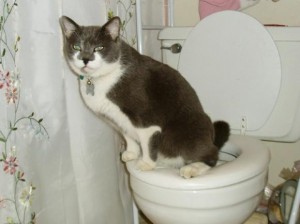Avoid Toilet Disasters: Don't Flush Cat Poop Down Your Toilet - Professional Advice
Avoid Toilet Disasters: Don't Flush Cat Poop Down Your Toilet - Professional Advice
Blog Article
On this page below you can find lots of exceptional additional info around Don’t flush cat feces down the toilet.

Introduction
As pet cat proprietors, it's essential to bear in mind exactly how we deal with our feline close friends' waste. While it may appear practical to purge cat poop down the commode, this practice can have damaging consequences for both the atmosphere and human wellness.
Environmental Impact
Flushing pet cat poop presents hazardous microorganisms and bloodsuckers right into the supply of water, presenting a substantial threat to water communities. These contaminants can adversely impact aquatic life and compromise water quality.
Wellness Risks
In addition to ecological issues, purging cat waste can likewise posture wellness risks to humans. Cat feces may contain Toxoplasma gondii, a parasite that can cause toxoplasmosis-- a potentially severe illness, particularly for pregnant women and people with weakened immune systems.
Alternatives to Flushing
Thankfully, there are more secure and much more liable methods to take care of pet cat poop. Take into consideration the complying with choices:
1. Scoop and Dispose in Trash
One of the most typical method of taking care of pet cat poop is to scoop it right into a biodegradable bag and toss it in the garbage. Be sure to use a dedicated litter scoop and deal with the waste without delay.
2. Usage Biodegradable Litter
Opt for biodegradable feline trash made from materials such as corn or wheat. These trashes are environmentally friendly and can be safely thrown away in the garbage.
3. Bury in the Yard
If you have a lawn, consider burying pet cat waste in a marked location away from vegetable yards and water resources. Make sure to dig deep enough to prevent contamination of groundwater.
4. Mount a Pet Waste Disposal System
Buy a pet dog waste disposal system specifically made for feline waste. These systems use enzymes to break down the waste, lowering odor and ecological effect.
Conclusion
Accountable pet possession expands beyond giving food and shelter-- it likewise entails appropriate waste monitoring. By refraining from flushing feline poop down the commode and going with alternative disposal methods, we can decrease our ecological footprint and shield human health and wellness.
Why Can’t I Flush Cat Poop?
It Spreads a Parasite
Cats are frequently infected with a parasite called toxoplasma gondii. The parasite causes an infection called toxoplasmosis. It is usually harmless to cats. The parasite only uses cat poop as a host for its eggs. Otherwise, the cat’s immune system usually keeps the infection at low enough levels to maintain its own health. But it does not stop the develop of eggs. These eggs are tiny and surprisingly tough. They may survive for a year before they begin to grow. But that’s the problem.
Our wastewater system is not designed to deal with toxoplasmosis eggs. Instead, most eggs will flush from your toilet into sewers and wastewater management plants. After the sewage is treated for many other harmful things in it, it is typically released into local rivers, lakes, or oceans. Here, the toxoplasmosis eggs can find new hosts, including starfish, crabs, otters, and many other wildlife. For many, this is a significant risk to their health. Toxoplasmosis can also end up infecting water sources that are important for agriculture, which means our deer, pigs, and sheep can get infected too.
Is There Risk to Humans?
There can be a risk to human life from flushing cat poop down the toilet. If you do so, the parasites from your cat’s poop can end up in shellfish, game animals, or livestock. If this meat is then served raw or undercooked, the people who eat it can get sick.
In fact, according to the CDC, 40 million people in the United States are infected with toxoplasma gondii. They get it from exposure to infected seafood, or from some kind of cat poop contamination, like drinking from a stream that is contaminated or touching anything that has come into contact with cat poop. That includes just cleaning a cat litter box.
Most people who get infected with these parasites will not develop any symptoms. However, for pregnant women or for those with compromised immune systems, the parasite can cause severe health problems.
How to Handle Cat Poop
The best way to handle cat poop is actually to clean the box more often. The eggs that the parasite sheds will not become active until one to five days after the cat poops. That means that if you clean daily, you’re much less likely to come into direct contact with infectious eggs.
That said, always dispose of cat poop in the garbage and not down the toilet. Wash your hands before and after you clean the litter box, and bring the bag of poop right outside to your garbage bins.
https://trenchlesssolutionsusa.com/why-cant-i-flush-cat-poop/

We were made aware of that write-up about Can You Flush Cat Poo or Litter Down the Toilet? from a friend on a different domain. Are you aware of another person who is excited about the topic? Why not share it. I cherish reading our article about Don’t flush cat feces down the toilet.
Visit Homepage Report this page